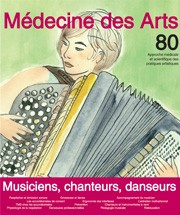Médecine des arts Journal N°80

Médecine des arts Journal N°80Artists’ Health, musicians, singers, dancers
Number 80 on the health of the singer, musician, and dancer
Medical and scientific approach to artistic practices
French Journal
Free shipping
In this issue of Medecine des arts Journal, you can read a study on breathing techniques of wind instruments players and singers for sound-emitting (biomechanical and physiological analysis).
Playing-related musculoskeletal disorders (PRMDs) in accordionists are well-known. An ergonomic and multidisciplinary approach of two professional accordion players suffering from severe PRMDs is presented. This study results also in a PRMDs prevention guide for accordion players.
Pregnancy and the postpartum period is a special time for the female dancers. Professional dancers are interviewed by the author, a physician, about their experiences during pregnancy and the postpartum period.
The practice of art especially at the highest level engages the individual as a whole, and motivation is important. How both the teacher and the therapist can strengthen and develop the motivation of the musician and more generally of the artist, using Motivational Interviewing?
Other topics are also developped.
Edito Arts Medicine N°80
Do Playing Wind Instruments and Singing Involve the Same Breathing Techniques ?
AbstractTo answer the question of whether wind instrument players and singers use the same breathing techniques, the author refers to ideas expressed by the trumpet player, Robert Pichaureau, about how to play this instrument. She uses biomechanics to analyze the breath-efficient technique recommended by this musician. The author then relates this biomechanical analysis to her own experience as an opera singer, and to an earlier physiological study she had conducted on classical singing.
The article also provides an overview of research on how wind instrument players control the air flow in supraglottal areas, and on how singers make proper use of the resonance cavities. Some grey areas are pointed out that would be interesting to explore.
Marie Hutois
Key words: Musician, Wind instrument, Singer, Breathing, Sound-emitting, Biomechanics, Robert Pichaureau,
Version papier
17€
Enhancing Collaboration and Developing Motivation When Working with Musicians
AbstractWhat teacher or therapist has never thought, or heard others say, that a musician they were teaching or treating “was resistant”, “lacked motivation”, or “didn’t want to change”? Motivational interviewing is seen as a response to this problem. It is a type of collaborative conversation that strengthens not only a person’s motivation but also his/her commitment to working toward behavioral change.
This way of helping people change — developed by two psychologists, William R. Miller and Stephen Rollnick — appeared in the USA and the United Kingdom in the 1980s, before spreading to an international level.
The article presents the principles and tools underlying this approach and explores its potential contributions to the fields of therapeutic treatment of musicians and music learning.
Christophe de Neckere
Key words: Motivational Interviewing; Behavioral Change; motivation; Psychotherapy; Musician; Rehabilitation; Music Learning.
Version papier
17€
Pregnancy and the Postpartum Period among Professional Dancers
AbstractIn order to identify female dancers’ experiences during pregnancy and its aftermath, a qualitative study was conducted by interviewing fourteen professional dancers. The results brought out the importance of listening to one’s body in this population, and that medical advice is seldom taken into account. The dancers generally felt that pregnancy was a positive experience, which goes to show that dancing and pregnancy are not incompatible. Attitudes about routine medical surveillance were ambivalent: it was considered demanding yet reassuring. During the postpartum period, the dancers went back to dancing despite the effort-related urinary incontinence reported by five dancers in the study.
It is the general practitioner's role to recommend physical exercise and sports activities during pregnancy and the postpartum period. The doctor’s medical care and follow-up must include screening for and treating effort-related urinary incontinence.
Nathalie Blasco
Key words: Professional Dancer, Pregnancy, Postpartum Period, Physical Exercise, Medical Surveillance, Health
Version papier
17€
An Ergonomic, Preventive and Therapeutic Approach to Musculoskeletal Disorders among Performing Accordionists
AbstractThe concert accordion, a magnificent instrument with a vast interpretative potential, is particularly demanding from the physical standpoint. There is no doubt that the weight of the instrument itself, and the extreme arm movements and strength needed to handle the bellows, may result in musculoskeletal disorders (MSD) that can hinder musical expression and become a genuine health threat for musicians. Opening the bellows requires a large combination of movements: the fingers must press down on the buttons at the same time as the left arm is making complex movements to work the bellows. It is important to note that, in the rare studies of physical disorders among accordion players, the straps (which support the instrument) are regularly said to be responsible for pain or even injuries.
The medical treatment of two professional accordion players suffering from severe MSD, both of whom are performers and teachers, was investigated via a multidisciplinary analysis of prevention techniques and possible ergonomic adaptations of the instrument. A think tank including these musicians, a medical doctor, a physical therapist, and six ergonomic engineering students produced prototypes of user-friendly straps for concert accordions and an MSD prevention guide for accordion players.
Véronique Moret, François Tardif
Key words: Accordion, Musculoskeletal Disorders,Prevention, Ergonomics, Straps, Multidisciplinarity, Health
Version papier
17€
Stage Fright N°80
Version papier
17€
Subscription, France, EEC (1 year, 2 issues)
34€
Subscription Outside EEC (1 year, 2 issues)
37€
Les garanties médecine des arts
Articles en stock
Envoi dans les 24h
Paiement
en ligne sécurisé
Une question ?
